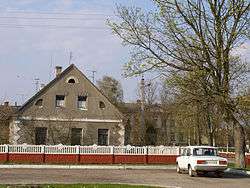Antopal
| Antopal Антопаль | |
|---|---|
|
Old bank in Antopal, 2009 | |
| Country |
|
| Region | Brest Region |
| District | Kobryn District |
Antopal or Antopol (Belarusian: Антопаль, Russian: Антополь, Yiddish: אנטיפאליע Antipolie) is an agrotown in Belarus near the towns of Kobryn and Brest (Brest-Litowski). The approximate population in a 7 kilometer area from the center of this town is 2,469.
Antopol is situated in the Polesian Lowland near the river Pripyat which flows into the Dnieper River. The Polesian Plain is a region of lakes and moors, well suited for agriculture. It changed hands frequently between Poland and Russia. Between the two world wars, western Polesia was part of the Kresy region of Poland.
Jews in Antopal
According to Encyclopedia Judaica published during the Cold War, Jews lived in Polesia already in the 14th century. They settled in Antopal in the middle of the 17th Century. The town has an old Jewish Cemetery and a bathhouse. During the Swedish occupation (1706) many Antopal Jews were killed. On the road to the town there are rows of Jewish graves, called "The Swedes." Two emissaries from Jerusalem visited Antopal in the 1880s and mentioned the Jewish community in their records. In 1847, there were 1108 Jews in Antopal and in 1897 about 3140, out of a total population of 3,870.
From time to time, fires broke out in the town. In 1869, almost the entire town was burned down and then rebuilt. Before the 2nd World War, there were 5 Beth Midrash in the town and also a Hassidic Shtibl. The old synagogue burned down during the 1st world war and a new synagogue was built in its place.
Presiding Judge of Antopal and the nearby town of Horodoff, Rabbi Haim S. Zalman Bressler, Rabbi Pinkas Michalek and Rabbi Mordechaie Wizel Rosenblatt. Rabbi Moshe Neeman Akiva of Antopal went to Israel and survived the Safed riots of 1834.
Like many other Polesian Jews, the Jewish inhabitants of Antopal made their living from agriculture. They were landowners and leaseholders. They grew corn and potatoes and had vegetable gardens. Peasants living in the vicinity worked for Jewish farmers. Agricultural cooperatives were founded in Antopal. Before the 1st World War, there were 21 Jewish farms in Antopal. After the war, the economic situation of the Jewish farmers worsened and they received assistance from the J.C.A.
Several famous Americans are descended from Antopal residents. For example, Metropolitan Opera singer Roberta Peters and fiction writer Molly Antopol, author of The UnAmericans (Jewish Colonisation Association).
20th century
Jews were occupied in fattening geese and imported sickles and scythes from Vienna. Many Jews were carters and hawkers. After Poland's return to independence between the two world wars, Antopol was assigned to Polesie Voivodeship in the Second Polish Republic and remained there until the Nazi-Soviet invasion of Poland in 1939.[1] Bus service was introduced in 1925; connecting Antopol with Kobryn, thereby advancing further development of commerce in the shtetl. In 1921 there were 1,792 Jews in the town, over half of its population of 2,206. In 1935, a new power station was built. A pharmacy opened. There was a dentist clinic and two physicians, one of whom was a family doctor.[2] At that time, many of the community's young people emigrated.
Soon after the Nazi German and the Soviet invasion of Poland at the outbreak of the World War II in September 1939, due to influx of Jews from German-occupied western part of Poland the number of Jews living in Antopol grew to 2,300 out of the total population of 3,000.[2] The area was controlled by the Soviet Union for two years. The Soviet administration requisitioned houses, mainly Jewish. Names of streets were changed: Zamkowa became Revolutionary Street and so on. All businesses were nationalized by the Soviet regime. The Germans captured the town during the 1941 Operation Barbarossa.[2] They deported the Jews to a ghetto from which they were taken to a killing site at Bronna Góra. The ghetto liquidation 'Aktion' that started on October 15, 1942 lasted for four days, until all Jews living in the Antopol Ghetto were killed.[2]
External links
- ↑ Echa Polesia 3 (39) 2013, Miejsca Pamięci Narodowej, Obwód Brzeski (Places of National Memory). Kresy24.pl – Wschodnia Gazeta Codzienna (daily) 2014.
- 1 2 3 4 המאמר לא זמין בשפה זו, נכון לעכשיו Antopol at Virtual Shtetl 2014.
- Antopal. Jewish Cemeteries JHRG Belarus.org (English)
- Antopal. Synagogues JHRG Belarus.org (English)
- Antopal. Holocaust JHRG Belarus.org (English)
- Antopal (1972), "Antopol". Yizkor Book by Herschel Burston, Tel-Aviv, 494 pages of scanned document. (English)
Coordinates: 52°12′N 24°47′E / 52.200°N 24.783°E
